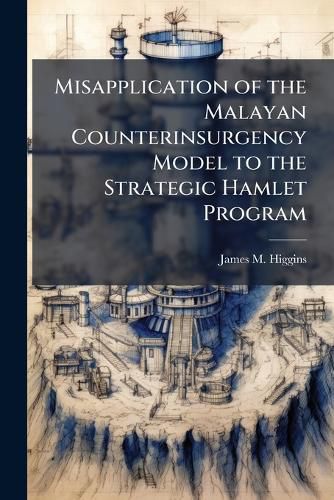Readings Newsletter
Become a Readings Member to make your shopping experience even easier.
Sign in or sign up for free!
You’re not far away from qualifying for FREE standard shipping within Australia
You’ve qualified for FREE standard shipping within Australia
The cart is loading…






This title is printed to order. This book may have been self-published. If so, we cannot guarantee the quality of the content. In the main most books will have gone through the editing process however some may not. We therefore suggest that you be aware of this before ordering this book. If in doubt check either the author or publisher’s details as we are unable to accept any returns unless they are faulty. Please contact us if you have any questions.
The strategic hamlet program in Vietnam was destined to failure because of a misapplication of the Malayan counterinsurgency model. The ethnic composition of the population, the nature of the insurgency, and the inherent capabilities of the bureaucracy created a unique set of conditions in Malaya. These conditions allowed the British colonial government to implement an effective counterinsurgency strategy that isolated the guerrillas. The focus of the strategy was the resettlement of the rural population away from the jungle. The South Vietnamese and their American and British advisers misapplied the Malayan strategy in the implementation of the strategic hamlet program. The program was designed to isolate the rural Vietnamese from the Viet Cong. The authorities, however, failed to understand how the conditions in South Vietnam differed from Malaya. The impact of these differences destined the program to failure. This thesis draws from primary sources written by personnel who were involved in both counterinsurgencies. It also outlines lessons learned from the misapplication that may be applied to future operations.
This work has been selected by scholars as being culturally important, and is part of the knowledge base of civilization as we know it. This work was reproduced from the original artifact, and remains as true to the original work as possible. Therefore, you will see the original copyright references, library stamps (as most of these works have been housed in our most important libraries around the world), and other notations in the work.
This work is in the public domain in the United States of America, and possibly other nations. Within the United States, you may freely copy and distribute this work, as no entity (individual or corporate) has a copyright on the body of the work.
As a reproduction of a historical artifact, this work may contain missing or blurred pages, poor pictures, errant marks, etc. Scholars believe, and we concur, that this work is important enough to be preserved, reproduced, and made generally available to the public. We appreciate your support of the preservation process, and thank you for being an important part of keeping this knowledge alive and relevant.
$9.00 standard shipping within Australia
FREE standard shipping within Australia for orders over $100.00
Express & International shipping calculated at checkout
Stock availability can be subject to change without notice. We recommend calling the shop or contacting our online team to check availability of low stock items. Please see our Shopping Online page for more details.
This title is printed to order. This book may have been self-published. If so, we cannot guarantee the quality of the content. In the main most books will have gone through the editing process however some may not. We therefore suggest that you be aware of this before ordering this book. If in doubt check either the author or publisher’s details as we are unable to accept any returns unless they are faulty. Please contact us if you have any questions.
The strategic hamlet program in Vietnam was destined to failure because of a misapplication of the Malayan counterinsurgency model. The ethnic composition of the population, the nature of the insurgency, and the inherent capabilities of the bureaucracy created a unique set of conditions in Malaya. These conditions allowed the British colonial government to implement an effective counterinsurgency strategy that isolated the guerrillas. The focus of the strategy was the resettlement of the rural population away from the jungle. The South Vietnamese and their American and British advisers misapplied the Malayan strategy in the implementation of the strategic hamlet program. The program was designed to isolate the rural Vietnamese from the Viet Cong. The authorities, however, failed to understand how the conditions in South Vietnam differed from Malaya. The impact of these differences destined the program to failure. This thesis draws from primary sources written by personnel who were involved in both counterinsurgencies. It also outlines lessons learned from the misapplication that may be applied to future operations.
This work has been selected by scholars as being culturally important, and is part of the knowledge base of civilization as we know it. This work was reproduced from the original artifact, and remains as true to the original work as possible. Therefore, you will see the original copyright references, library stamps (as most of these works have been housed in our most important libraries around the world), and other notations in the work.
This work is in the public domain in the United States of America, and possibly other nations. Within the United States, you may freely copy and distribute this work, as no entity (individual or corporate) has a copyright on the body of the work.
As a reproduction of a historical artifact, this work may contain missing or blurred pages, poor pictures, errant marks, etc. Scholars believe, and we concur, that this work is important enough to be preserved, reproduced, and made generally available to the public. We appreciate your support of the preservation process, and thank you for being an important part of keeping this knowledge alive and relevant.